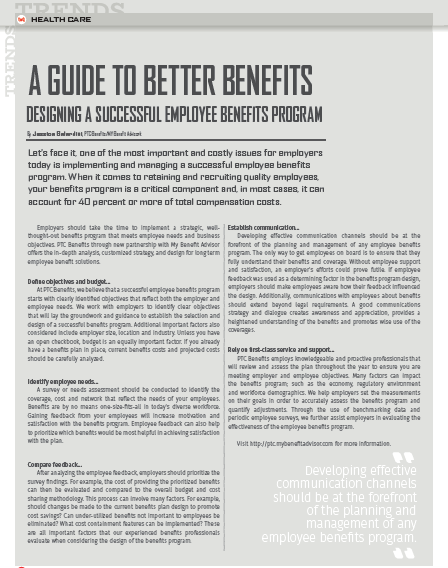A GUIDE TO BETTER BENEFITS DESIGNING A SUCCESSFUL EMPLOYEE BENEFITS PROGRAM
By Jessica Galardini, PTC Benefits/MY Benefit Advisor
Let’s face it, one of the most important and costly issues for employers today is implementing and managing a successful employee benefits program. When it comes to retaining and recruiting quality employees, your benefits program is a critical component and, in most cases, it can account for 40 percent or more of total compensation costs.
Employers should take the time to implement a strategic, well-thought-out benefits program that meets employee needs and business objectives. PTC Benefits through new partnership with My Benefit Advisor offers the in-depth analysis, customized strategy, and design for long term employee benefit solutions.
Define objectives and budget…
At PTC Benefits, we believe that a successful employee benefits program starts with clearly identified objectives that reflect both the employer and employee needs. We work with employers to identify clear 
Identify employee needs…
A survey or needs assessment should be conducted to identify the coverage, cost and network that refl ect the needs of your employees. Benefi ts are by no means one-size-fi ts-all in today’s diverse workforce. Gaining feedback from your employees will increase motivation and satisfaction with the benefi ts program. Employee feedback can also help to prioritize which benefi ts would be most helpful in achieving satisfaction with the plan.
Compare feedback…
After analyzing the employee feedback, employers should prioritize the survey findings. For example, the cost of providing the prioritized benefits can then be evaluated and compared to the overall budget and cost sharing methodology. This process can involve many factors. For example, should changes be made to the current benefits plan design to promote cost savings? Can under-utilized benefits not important to employees be eliminated? What cost containment features can be implemented? These are all important factors that our experienced benefits professionals evaluate when considering the design of the benefits program.
Establish communication…
Developing effective communication channels should be at the forefront of the planning and management of any employee benefi ts program. The only way to get employees on board is to ensure that they fully understand their benefits and coverage. Without employee support and satisfaction, an employer’s efforts could prove futile. If employee feedback was used as a determining factor in the benefits program design, employers should make employees aware how their feedback influenced the design. Additionally, communications with employees about benefits should extend beyond legal requirements. A good communications strategy and dialogue creates awareness and appreciation, provides a heightened understanding of the benefits and promotes wise use of the coverages.
Rely on first-class service and support…
PTC Benefits employs knowledgeable and proactive professionals that will review and assess the plan throughout the year to ensure you are meeting employer and employee objectives. Many factors can impact the benefits program; such as the economy, regulatory environment and workforce demographics. We help employers set the measurements on their goals in order to accurately assess the benefits program and quantify adjustments. Through the use of benchmarking data and periodic employee surveys, we further assist employers in evaluating the effectiveness of the employee benefits program.
Visit http://ptc.mybenefitadvisor.com for more information.